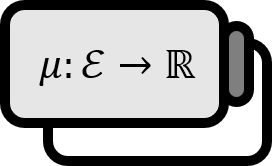Lebesgue Measurable Functions
Definition 1
A function $f: E \in \overline{ \mathbb{R} }$ is said to be (Lebesgue) measurable if for every interval $I \subset \overline{ \mathbb{R} }$, $$ f^{-1} (I) = \left\{ x \in \mathbb{R} \ | \ f(x) \in I \right\} \in \mathcal{M} $$ holds.
- $\overline{ \mathbb{R} } = \mathbb{R} \cup \left\{ - \infty , + \infty \right\}$ refers to the extended real number space, which includes positive and negative infinity, in the $1$-dimensional Euclidean space.
Equivalent Conditions
The following propositions are equivalent to each other:
- (1): $f$ is a Lebesgue measurable function.
- (2): For all $r \in \mathbb{R}$, $f^{-1} ( - \infty , r ] \in \mathcal{M}$ holds.
- (3): For all $r \in \mathbb{R}$, $f^{-1} (r, \infty ) \in \mathcal{M}$ holds.
- (4): For all $r \in \mathbb{R}$, $f^{-1} ( - \infty , r ) \in \mathcal{M}$ holds.
- (5): For all $r \in \mathbb{R}$, $f^{-1} [r, \infty ) \in \mathcal{M}$ holds.
Theorem
- [1]: A necessary and sufficient condition for $f$ to be measurable is that for every open set $O$, $f^{-1} ( O ) \in \mathcal{M}$ holds.
- [2]: A necessary and sufficient condition for $f |_{E}$ to be measurable, given $D \subset E$ and $D \in \mathcal{M}$, is that $f |_{D}$ and $f |_{E \setminus D}$ are measurable.
- [3]: Continuous functions are measurable.
- [4]: Indicator functions are measurable.
- [5]: Monotonic functions are measurable.
- $f |_{X}$ denotes a contraction mapping that restricts the domain to $X$ and satisfies $f = f |_{X}$.
- An Indicator Function refers to a function that is $1$ if it belongs to a certain set, and $0$ otherwise. $$\displaystyle \mathbb{1}_{E} (x) = \chi _{E} (x) = \begin{cases} 1 & , x \in E \\ 0 & , x \notin E \end{cases}$$ Note that this definition omits the condition $E \in \mathcal{M}$, so care should be taken.
Explanation
For easier manipulation, it’s convenient to use the original definition of pre-image, $f^{-1} (-\infty , r) = \left\{ x \in E \ | \ f(x) < r \right\}$.
If all intervals $I \subset \mathbb{R}$ satisfy $f^{-1} (I) = \left\{ x \in \mathbb{R} \ | \ f(x) \in I \right\} \in \mathcal{B}$ under the conditions for a Lebesgue measurable function, it is called Borel measurable and referred to as a Borel function.
Extended real numbers $\overline{\mathbb{R}} : = [ - \infty, \infty]$ include infinity as a point along with the entire set of real numbers. Although infinity has been a daunting and difficult concept in analysis, it is now just another entity to conquer. Don’t be too afraid, and try to regain the flexible thinking of your high school days.
Considering a general measurable space, [1] can also become the definition of a measurable function.
Proof
[1]
Considering closed intervals, it is sufficient to only consider open intervals since adding two points at each end of a closed interval suffices.
$(\Rightarrow)$
Defining open intervals $A_{k} := (a_{k}, \infty)$, $B_{k} := (b_{k}, \infty)$, since $f$ is a measurable function, $$f^{-1} (A_{k}), f^{-1} (B_{k}) \in \mathcal{M}$$ any open set $O \subset \overline{ \mathbb{R} }$ can be represented as $\displaystyle O = \bigcup_{k=1}^{\infty} A_{k} \cap B_{k}$, hence, $$\displaystyle f^{-1} ( O ) = f^{-1} \left[ \bigcup_{k=1}^{\infty} A_{k} \cap B_{k} \right] = \bigcup_{k=1}^{\infty} \left[ f^{-1} (B_{k}) \cap f^{-1} (B_{k}) \right]$$ by the properties of the σ-field, it follows that $f^{-1} ( O ) \in \mathcal{M}$.
$(\Leftarrow)$ Since $f^{-1} ( O ) \in \mathcal{M}$ holds for all open sets $O \subset \overline{ \mathbb{R} }$, it also holds for all open intervals $(a,b) \subset \overline{ \mathbb{R} }$.
By the definition of a measurable function, $f$ is a measurable function.
■
Capinski. (1999). Measure, Integral and Probability: p57. ↩︎
